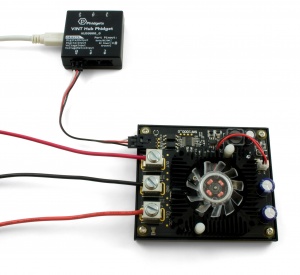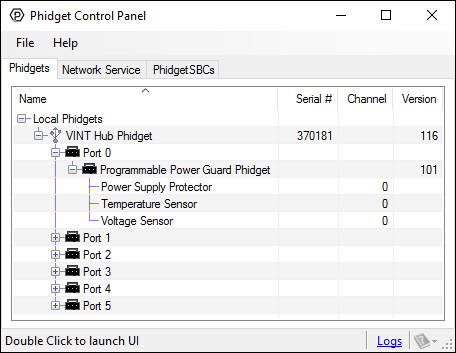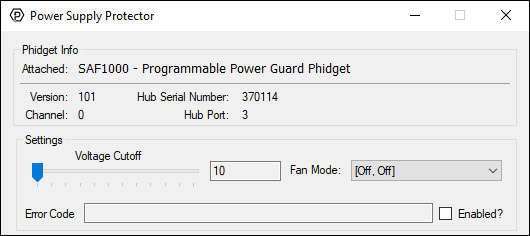SAF1000 User Guide: Difference between revisions
No edit summary |
|||
| Line 5: | Line 5: | ||
* A SAF1000 Programmable Power Guard Phidget | * A SAF1000 Programmable Power Guard Phidget | ||
* A | * A {{VINTHub}} | ||
* A Power supply | * A Power supply | ||
* A 3-wire Phidget cable | * A 3-wire Phidget cable | ||
Revision as of 16:31, 7 April 2017

Required Hardware
- A SAF1000 Programmable Power Guard Phidget
- A VINT Hub
- A Power supply
- A 3-wire Phidget cable
- A USB cable
- A computer
Connecting the Pieces
- Connect the SAF1000 to your VINT Hub using the Phidget cable.
- Connect the VINT Hub to your computer using the USB cable.
- Connect the positive power terminal of the device you're powering to the "OUT" terminal on the SAF1000.
- Connect the ground terminal of the device you're powering to the ground terminal on the SAF1000.
- Connect the positive and negative wires of your power supply to the "Vin" and "GND" terminals of the SAF1000, respectively.
- Plug in your power supply.
Testing Using Windows
Phidget Control Panel
In order to demonstrate the functionality of the SAF1000, the Phidget Control Panel running on a Windows machine will be used.
The Phidget Control Panel is available for use on both macOS and Windows machines.
Windows
To open the Phidget Control Panel on Windows, find the ![]() icon in the taskbar. If it is not there, open up the start menu and search for Phidget Control Panel
icon in the taskbar. If it is not there, open up the start menu and search for Phidget Control Panel
macOS
To open the Phidget Control Panel on macOS, open Finder and navigate to the Phidget Control Panel in the Applications list. Double click on the ![]() icon to bring up the Phidget Control Panel.
icon to bring up the Phidget Control Panel.
For more information, take a look at the getting started guide for your operating system:
Linux users can follow the getting started with Linux guide and continue reading here for more information about the SAF1000.
First Look
After plugging the SAF1000 into your computer and opening the Phidget Control Panel, you will see something like this:

The Phidget Control Panel will list all connected Phidgets and associated objects, as well as the following information:
- Serial number: allows you to differentiate between similar Phidgets.
- Channel: allows you to differentiate between similar objects on a Phidget.
- Version number: corresponds to the firmware version your Phidget is running. If your Phidget is listed in red, your firmware is out of date. Update the firmware by double-clicking the entry.
The Phidget Control Panel can also be used to test your device. Double-clicking on an object will open an example.
Power Supply Protector
Double click on the Power Supply Protector object in order to run the example:

General information about the selected object will be displayed at the top of the window. You can also experiment with the following functionality:
- Adjust the voltage cutoff slider to determine at which voltage the SAF1000 will cut power to your system.
- Select the fan mode- on, off, or auto (automatically turns on when board reaches 70°C, turns off after dropping below 55°C)
- Click the enabled box once the cutoff and fan mode are set in order to activate the SAF1000.
Temperature Sensor {{{3}}}
Double-click on the Temperature Sensor object {{{2}}} in order to run the example: [[Image:{{{1}}}_TemperatureSensorIC_Example.jpg|center|link=]]
General information about the selected object will be displayed at the top of the window. You can also experiment with the following functionality:
- Modify the change trigger and/or data interval value by dragging the sliders. For more information on these settings, see the data interval/change trigger page.
- The measured temperature can be seen next to the Temperature label. Cover the board with your hands to see the temperature quickly rise.
Supply Voltage Input
Double-click on a Supply Voltage Input object in order to run the example: [[Image:{{{1}}}_VoltageInputSupply_Example.jpg|center|link=]]
General information about the selected object will be displayed at the top of the window. You can also experiment with the following functionality:
- At the top of the window, information about your device and the properties of this particular channel will be listed.
- On the left, change trigger and/or data interval can be changed. For more information on these settings, see the Data Rate/Change Trigger page.
- On the right, the supply voltage of the Phidget is displayed in real-time.
Testing Using Mac OS X
- Go to the Quick Downloads section on the Mac OS X page.
- Download and run the Phidget OS X Installer
- Click on System Preferences >> Phidgets (under Other) to activate the Preference Pane
- Make sure your device is properly attached
- Double click on your device's objects in the listing to open them. The Preference Pane and examples will function very similarly to the ones described above in the Windows section.
Testing Using Linux
For a general step-by-step guide on getting Phidgets running on Linux, see the Linux page.
Using a Remote OS
We recommend testing your Phidget on a desktop OS before moving on to remote OS. Once you've tested your Phidget, you can go to the PhidgetSBC, or iOS pages to learn how to proceed.
Technical Details
What to do Next
- Programming Languages - Find your preferred programming language here and learn how to write your own code with Phidgets!
- Phidget Programming Basics - Once you have set up Phidgets to work with your programming environment, we recommend you read our page on to learn the fundamentals of programming with Phidgets.
